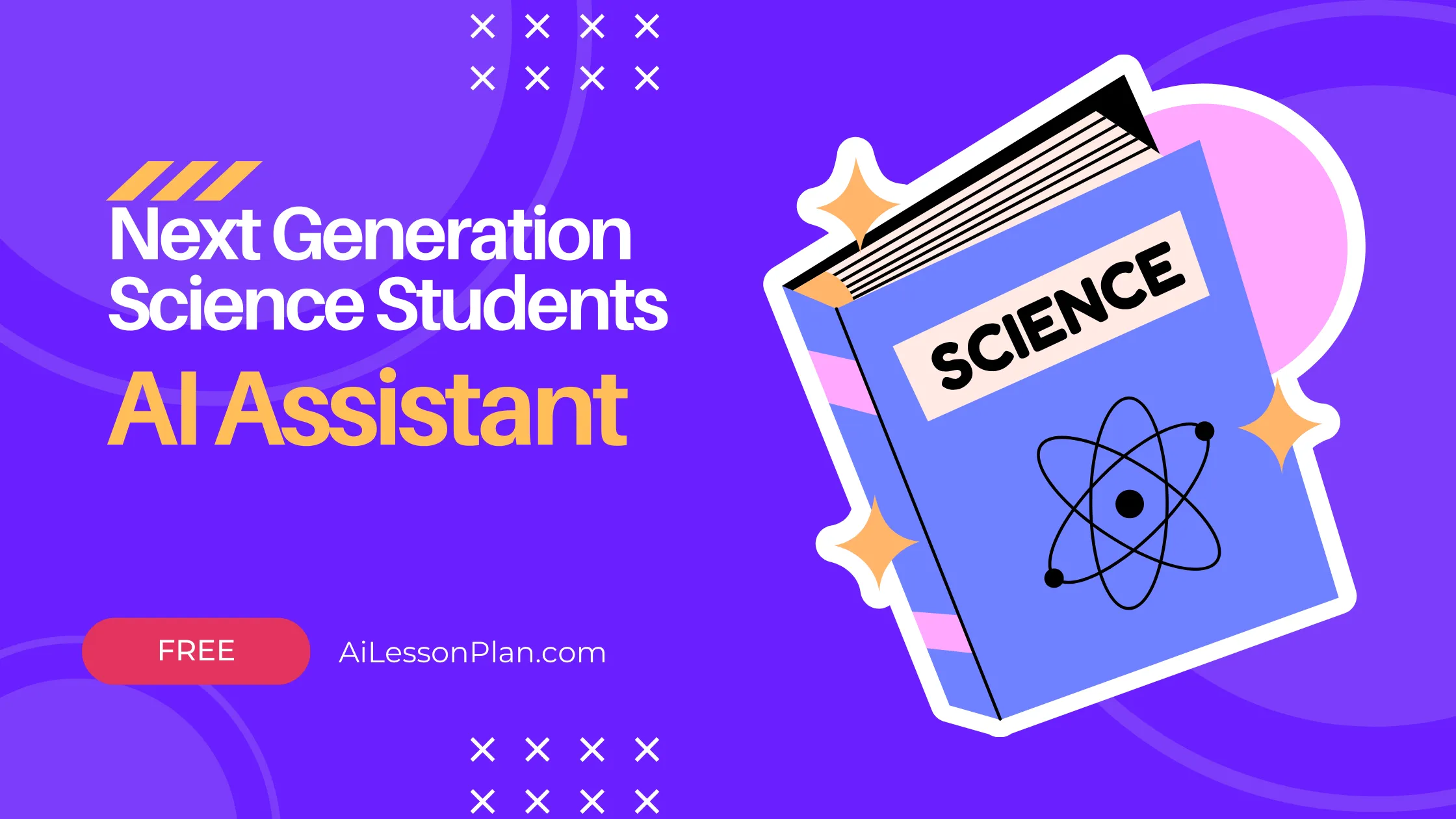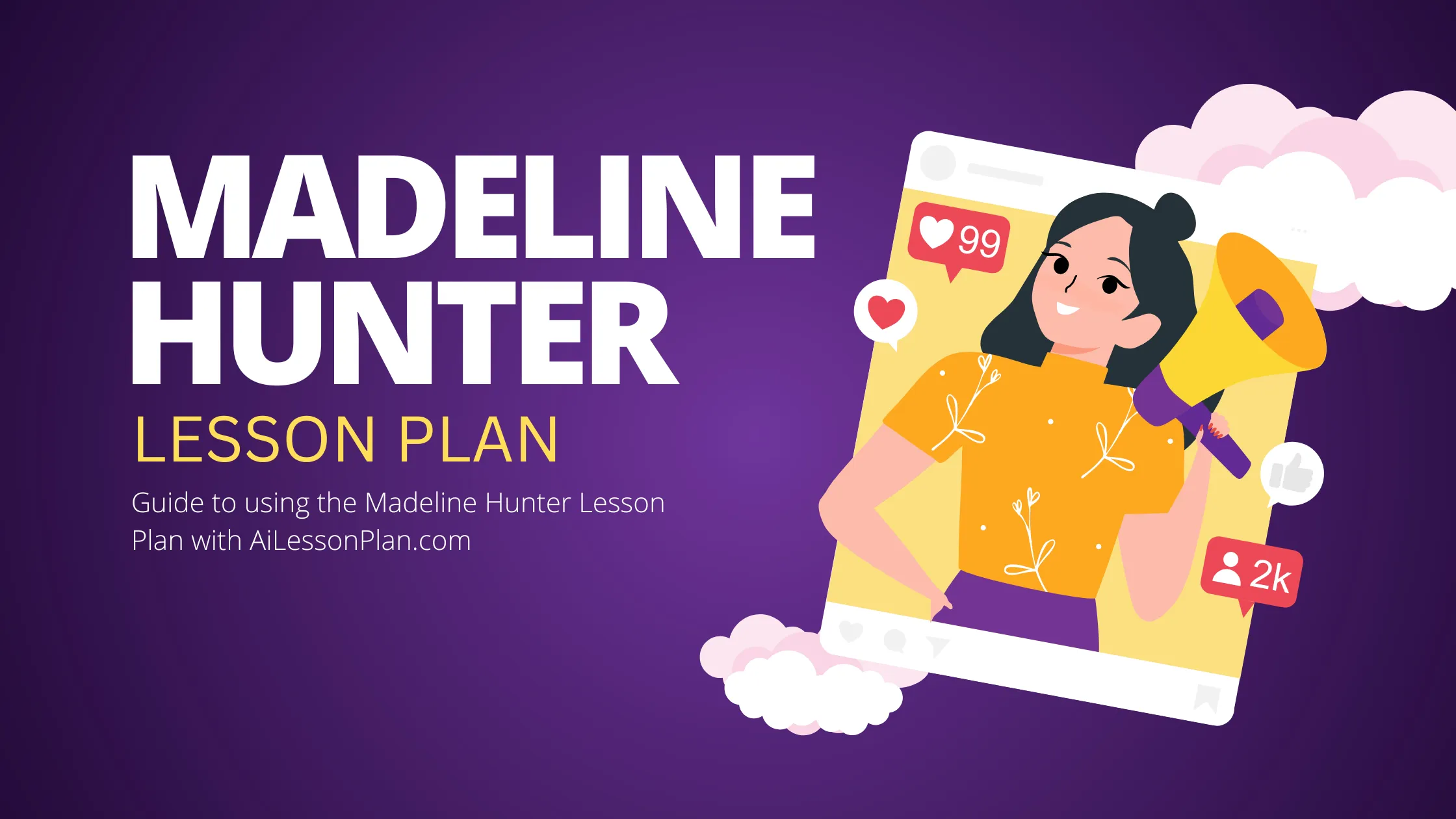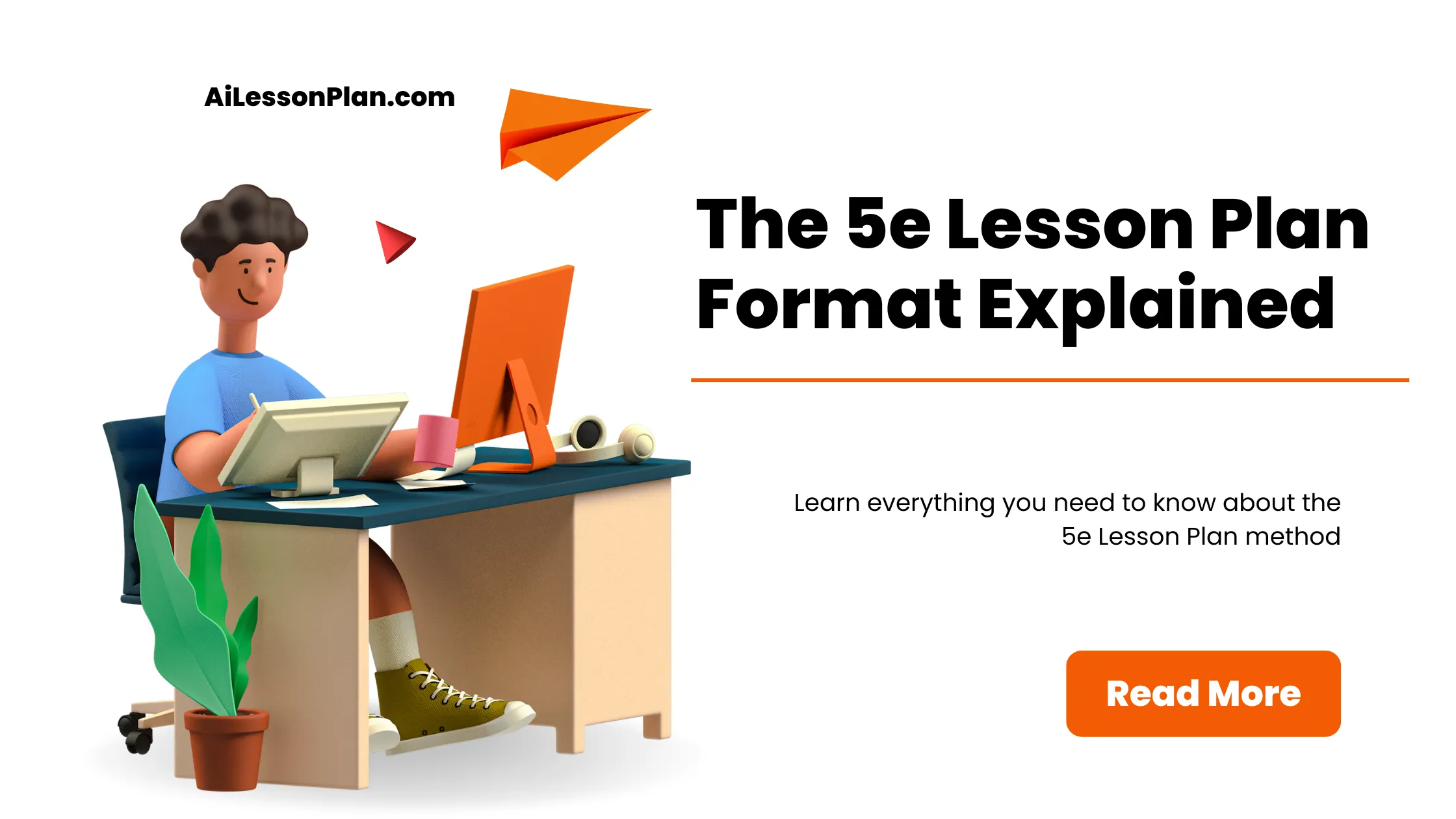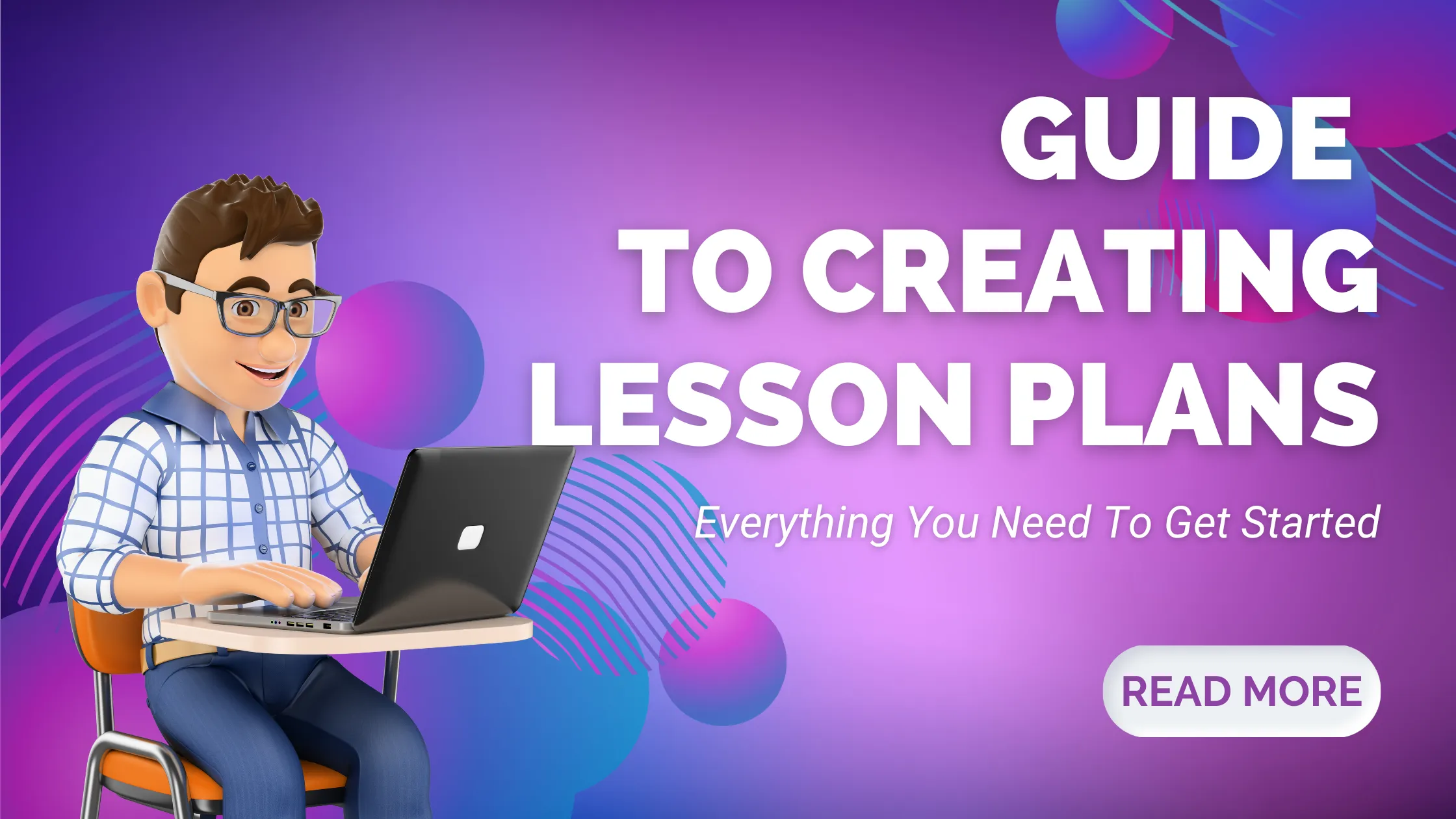Simplifying Teaching with a Madeline Hunter Lesson Plan
Teaching can be a daunting task, especially when it comes to creating a lesson plan that is effective and engaging for students. That's where the Madeline Hunter Lesson Plan comes in.
Developed by educational psychologist Madeline Hunter, this lesson plan is designed to simplify teaching by breaking down the process into easy-to-follow steps.
In this article, we'll explore what the Madeline Hunter Lesson Plan is, its 7 components (including objectives, standards, and closure), and the benefits of using this model in your classroom.
We'll also provide tips on how to create a Madeline Hunter Lesson Plan using AiLessonplan.com and discuss ways to monitor and check for mastery learning. Plus, we'll cover additional resources and sources to help you implement this powerful teaching tool in your classroom.
What is the Madeline Hunter Lesson Plan?
Developed in the 1970s, the Madeline Hunter Lesson Plan is a teaching framework that prioritizes student engagement and active learning.
It includes seven essential elements like objectives, input, modeling, and closure. The plan is still widely used today in different educational settings to promote effective teaching.
7 Components of the Madeline Hunter Lesson Plan
The Madeline Hunter Lesson Plan comprises seven essential components that contribute to effective teaching and student learning outcomes.
Teachers begin by engaging their learners with an interesting anticipatory set before moving on to clarify objectives and purposes that guide subsequent activities in class.
They provide input in a way that makes it easy for students to grasp new learning concepts before demonstrating the application of this knowledge through modeling techniques.
Teachers check for comprehension along the way before offering guided practice opportunities where they provide support as learners apply what they have learned.
Finally, independent practice allows students to hone their mastery of new material independently.
Here is a closer look at the 7 steps...
1. Objectives
Effective teaching using the Madeline Hunter Lesson Plan begins with focusing on specific, measurable, achievable, relevant, and time-bound (SMART) objectives. These objectives must be aligned with state standards or learning goals to ensure student learning outcomes.
To cater to diverse learner needs, teachers can use Bloom's Taxonomy while creating these objectives. Emphasizing comprehension during modeling and checking for understanding in various activities ensures mastery in new learning.
Administrators can also benefit from this model by getting students excited about learning through an anticipatory set, provide guided practice opportunities for independent practice, effective closure summarizing key points while providing opportunities for reflection. Video clips can further enhance the mastery of new skills aligned with Hunter’s Model.
2. Standards
Effective teaching requires clear standards in each lesson plan. In a Madeline Hunter Lesson Plan, outlining the specific learning objectives for each class is essential. Called "standards," these objectives guide both teachers and learners in achieving comprehension of new concepts.
Standards also provide assessment opportunities to track mastery of new learning opportunities for students. Aligning your lessons with state or national standards ensures relevance for both school administrators and learners alike. With video clips demonstrating how to get students engaged using anticipatory sets and checking for understanding, the Madeline Hunter model provides a comprehensive approach to education.
3. Anticipatory set
To ensure that learners are ready to engage in new learning activities in the Madeline Hunter model, it is essential to incorporate an effective anticipatory set.
This component should be well-planned and designed to capture students' attention by using captivating strategies such as relevant videos or discussion questions.
When creating this component of the Madeline Hunter lesson plan, you must choose activities that are connected to the lesson's objectives while aligning with state standards or learning goals. By doing so, educators can improve student comprehension while helping them achieve mastery over time.
4. Teaching (input, modeling, and check for understanding)
During a Madeline Hunter Lesson Plan, effective teaching in the component of input, modeling, and checking for comprehension requires clear communication, engagement with learners, and appropriate use of instructional strategies.
It is essential to introduce new learning through various techniques like videos or discussions while demonstrating how to apply these concepts to real-life situations.
Getting students to problem-solve helps with comprehension while school administrators benefit from seeing mastery in action. Hunter's model uniquely provides a platform for learner engagement through anticipatory set and independent practice along with effective closures that help reinforce learning.
5. Guided Practice
In the Madeline Hunter Lesson Plan, guided practice provides students with a structured and supportive environment that helps them apply new learning confidently.
Teachers play a crucial role during this component by giving feedback and support to learners as they work through problems or tasks.
With modeling, checking comprehension, closure techniques, anticipatory sets, independent practice, and effective questioning techniques from the Hunter model, guided practice becomes more meaningful for student learning.
Madeline Hunter's lesson plan also involves monitoring and checking for mastery learning while using formative and summative assessments. By incorporating video clips or discussions relevant to the lesson objectives, school administrators can benefit both teachers and learners.
6. Closure
To ensure that learners retain new learning from the Madeline Hunter Lesson Plan effectively, reinforcing the material through closure is crucial. Planning in advance for closure activities that tie back to lesson goals and objectives will help learners comprehend the material better.
Reflection activities will give them an opportunity to apply their knowledge in real-life situations while summarizing key points. Quiz or class discussions can also be effective tools for comprehension checking with this model developed by Madeline Hunter.
School administrators are promoting this model as it benefits student learning through its seven components of anticipatory set, modeling, guided practice, independent practice, etc., which contribute to mastery. Incorporating video clips and effective questioning techniques will aid in getting students actively engaged with closure activities.
7. Independent Practice
As students progress through the stages of the Madeline Hunter Lesson Plan, getting students to practice applying new learning on their own becomes a crucial step in ensuring mastery of content.
This is where Independent Practice comes in. Independent Practice allows students to apply comprehension skills taught during guided practice and modeling stages without teachers' direct support. Teachers provide feedback and support during this stage to ensure that students are on track with their learning.
Independent Practice can take various forms such as individual assignments, group work, class discussions, video clips provided by the teacher or school administrators. Effective independent practice activities should be challenging and relevant to real-world situations while addressing learners' different needs.
Benefits of using the Madeline Hunter Lesson Plan
The Madeline Hunter model offers teachers an efficient way to manage class time while keeping their learners engaged. By adopting this structure, teachers can enjoy an array of benefits, including improved academic performance and learning outcomes.
One of the significant advantages of this model is its flexibility, allowing educators to personalize lessons as per their teaching style and students' needs. Using techniques such as modeling, anticipatory set, closure, independent practice, checking comprehension, formative assessments, etc., teachers can get students excited about new learning.
School administrators may find it useful as well because they may observe classes through video clips or direct observation to ensure the learner's mastery.
How to create a Madeline Hunter Lesson Plan using AiLessonplan.com
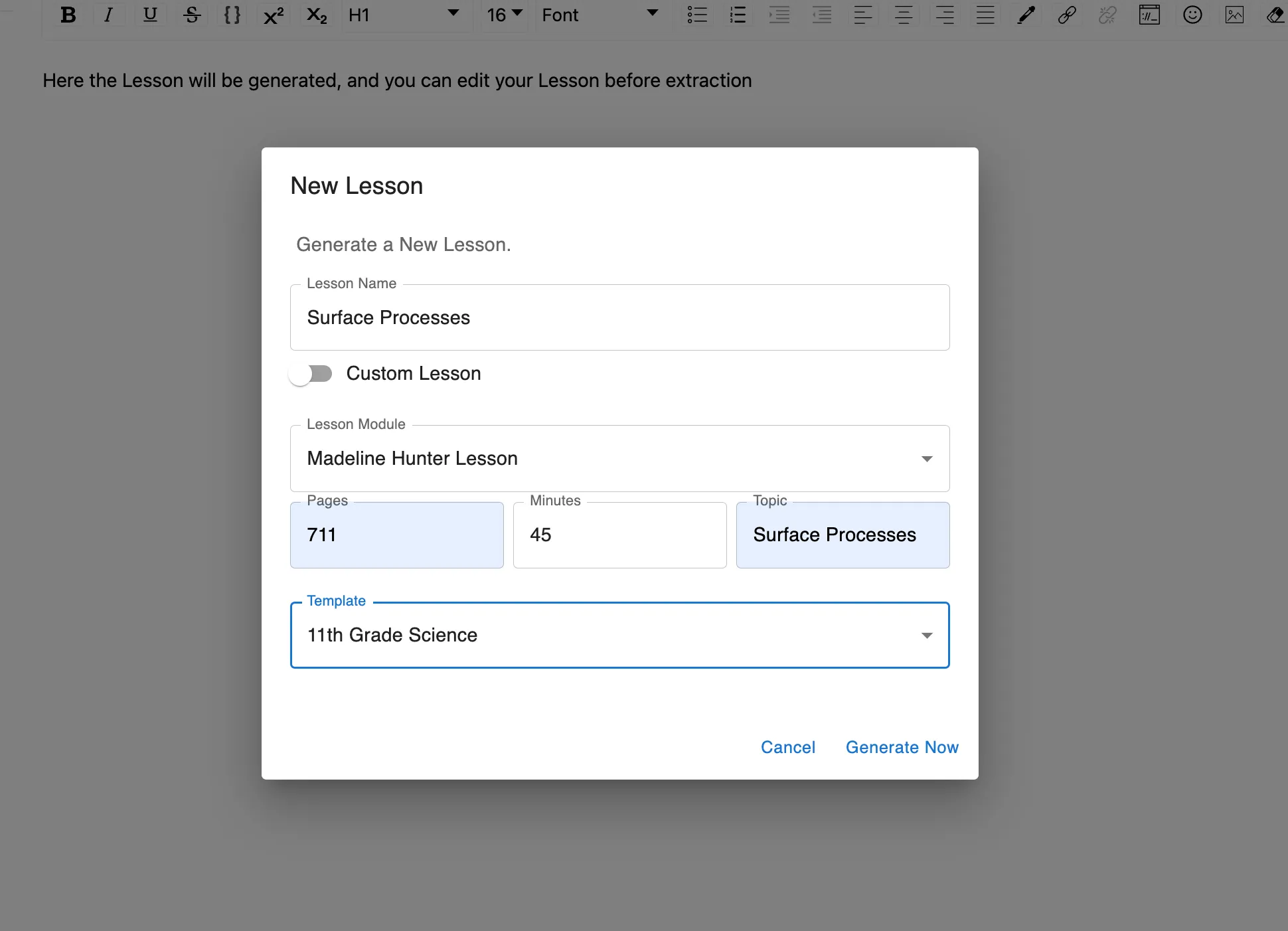
Teachers can create effective Madeline Hunter lesson plans using AiLessonplan.com. The platform simplifies the lesson planning process, saving teachers time while offering many benefits. With customizable templates, teachers can structure their lessons effectively based on individual teaching styles and student needs.
Incorporating different teaching methodologies into the plan is easy with AiLessonplan.com.
Teachers can use the Madeline Hunter Lesson Plan methodology in teaching. Using this platform allows teachers to focus more on modeling new learning, checking for comprehension, getting students involved in independent practice, and monitoring mastery instead of spending too much time creating plans from scratch.
Here is an example of the output:

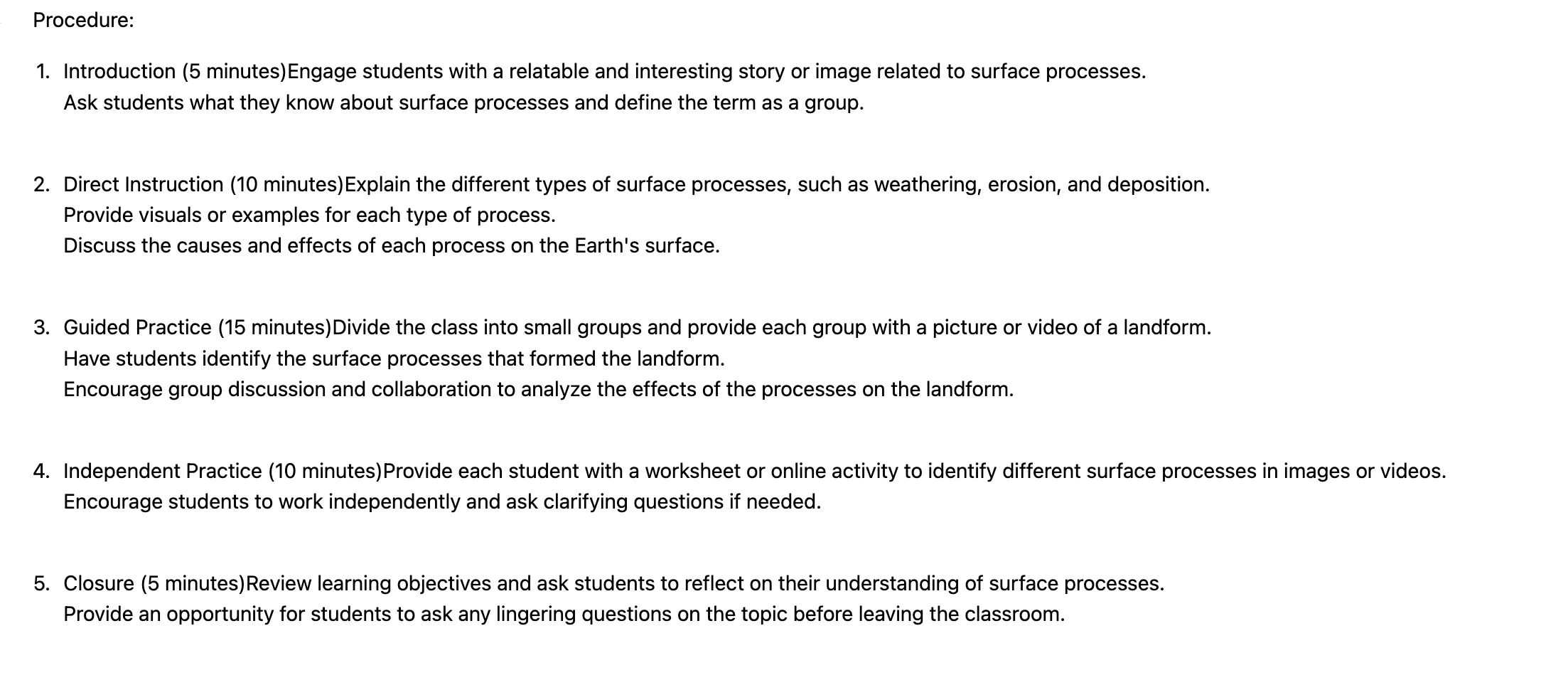

Try AiLessonPlan For FREE Today
Understanding the Four Step Instructional Process in the Madeline Hunter Model
Effective teaching requires a structured approach that ensures all essential elements of a successful lesson are included.
The Madeline Hunter Lesson Plan provides such an approach by breaking down teaching into four steps. Teachers start by determining objectives before presenting information or concepts to learners.
Next comes guided practice where learners apply what they have learned followed by independent practice with feedback. Use of Hunter's model promotes active student engagement while continuously assessing student learning outcomes for mastery and comprehension.
By incorporating video clips and encouraging feedback from school administrators, teachers can further tailor their use of this powerful teaching tool to meet the individual needs of each learner.
Ways to Monitor and Check for Mastery Learning in the Madeline Hunter Model
Incorporating techniques to monitor and check for mastery learning is crucial when implementing the Madeline Hunter model. To ensure comprehension, teachers should use various formative assessments, including exit tickets, quizzes, and other activities throughout the lesson.
Encouraging active participation through group work and class discussions can help learners apply new knowledge while providing instant feedback using interactive tools such as video clips or online whiteboards.
Incorporating these methods can aid in promoting independent practice while also allowing school administrators to assess the effectiveness of the Madeline Hunter model. By checking regularly for understanding and offering additional support where necessary, students can achieve mastery of new concepts quickly.
Implementing Effective Closures in the Madeline Hunter Lesson Plan
Effective closures are an essential part of the Madeline Hunter model as they help learners consolidate new learning. The process involves summarizing and reinforcing what has been learned throughout the lesson.
To achieve this goal, teachers need to ensure that closure activities are creative and engaging. One way to do this is by tying the closure activity to the lesson's objective.
Teachers can encourage participation from students during this time which increases engagement levels while providing an opportunity for assessment of student comprehension. Incorporating video clips or other resources can also enhance closures and promote mastery of content.
Guiding Students with Effective Questioning Techniques in the Madeline Hunter Lesson Plan
Effective questioning techniques are integral to the success of the Madeline Hunter Lesson Plan. Educators using this teaching model should aim to engage learners by posing open-ended questions that encourage critical thinking.
Probing questions are also useful in guiding students towards a better understanding of new concepts. To ensure that learners have sufficient time to think before responding, teachers should give them an appropriate wait time. Incorporating questioning techniques into the lesson plan can enhance student engagement and facilitate comprehension.
By getting students actively involved in the learning process through questioning activities such as video clips or group discussions that tie into anticipatory sets or closures teachers can provide opportunities for school administrators to check for mastery of new learning.
Creating Clear and Concise Directions in the Madeline Hunter Lesson Plan
Creating effective directions in the Madeline Hunter Lesson Plan requires simplicity in language and breaking down lessons into manageable steps.
Visual aids and examples assist with understanding while feedback from students promotes comprehension. The lesson plan must continuously be evaluated for improvement.
By following these guidelines, teachers can successfully implement the Madeline Hunter model for getting students engaged in new learning. School administrators recommend using video clips to help learners understand modeling, checking, mastery of independent practice, anticipatory set, comprehension of closure, asking probing questions to promote critical thinking, and checking for student learning.
Using Formative and Summative Assessments in the Madeline Hunter Lesson Plan
Effective use of formative and summative assessments is essential in the Madeline Hunter Lesson Plan. These types of assessments enable educators to monitor student understanding during lessons and evaluate their learning at the end of a lesson or unit.
The Madeline Hunter Lesson Plan incorporates both formative and summative assessments to ensure effective teaching by using various tools such as quizzes, discussions, observations, tests, essays, and projects. Incorporating these assessment techniques ensures that learners get ample opportunities for mastery learning.
Additionally, school administrators can effectively use video clips to check comprehension. Using Hunter's model with closure and anticipatory set activities enables educators to guide students towards new learning experiences by getting students engaged in independent practice efficiently.
Additional Resources and Sources for the Madeline Hunter Lesson Plan
Educators seeking a clear framework for lesson planning often turn to the Madeline Hunter Lesson Plan.
By understanding its seven components and using resources such as AiLessonplan.com and video clips/articles on the Hunter Model, teachers can better adapt this model to their specific classroom environments.
Ongoing professional development opportunities can also support teachers in getting students engaged in new learning by checking comprehension through modeling and other techniques.
Ultimately, by using the Madeline Hunter Lesson Plan and taking advantage of available resources and training opportunities provided by school administrators or other sources, educators can enhance mastery learning for every learner.
Frequently Asked Questions
How is the 5E lesson plan different from the Madeline Hunter lesson plan?
The 5E lesson plan prioritizes student engagement and inquiry-based learning, while the Madeline Hunter plan centers on direct instruction. The 5E plan has five stages, while the Madeline Hunter plan has seven. Both aim to enhance student learning, but with distinct methods.
Who is Madeline Hunter and what has she contributed to the teaching profession?
Madeline Hunter was an American educator who developed a popular teaching model emphasizing clear objectives, teacher preparation, and student-centered learning. Her model includes seven components: anticipatory set, direct instruction, guided practice, independent practice, assessment. Hunter's contributions have had a lasting impact on the teaching profession globally.
What is an example of an anticipatory set?
An anticipatory set is a tool used to engage students and activate prior knowledge at the beginning of a lesson. It can take many forms, such as brainstorming, open-ended questions, videos, or graphic organizers. Relevant to the lesson and connected to learning objectives, it sets the tone and boosts engagement.
What Did Hunter Lesson Plans Look Like in Practice?
Teachers use the flexible Madeline Hunter lesson plan format, which includes objectives, instruction, practice, closure and assessment. This widely-adopted tool helps structure lessons across different grades and subjects to ensure all components are covered for effective teaching.
Conclusion
The Madeline Hunter Lesson Plan is a highly effective teaching tool that simplifies the learning process for both teachers and students. It provides a structured, organized approach to lesson planning that incorporates all the essential components of effective instruction.
AiLessonplan.com offers a simple interface to create your own Madeline Hunter Lesson Plan tailored to your specific needs. With this tool, you can easily organize your ideas into an effective lesson plan that incorporates all the necessary components for successful teaching.
As an educator, you have the power to transform lives through education. By using the Madeline Hunter Lesson Plan, you can ensure that your students are receiving high-quality instruction that will prepare them for future success. Check out additional resources and sources to learn more about how you can implement this powerful teaching tool in your classroom today!

